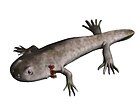아크로플러스
Acroplous| 아크로플러스 | |
|---|---|
 | |
| 과학적 분류 | |
| 왕국: | 애니멀리아 |
| 문: | 챠다타 |
| 클래스: | 양서류 |
| 주문: | †템노스폰딜리 |
| 서브오더: | †드비노사우루스속 |
| 패밀리: | †에오브라키오피과 |
| 속: | †아크로플러스 호튼, 1959년 |
| 모식종 | |
| 아크로플러스 볼락스 호튼, 1959년 | |
아크로플러스([1]Acroplous)는 데비노사우루스과 템노스폰딜리의 멸종된 속이다.
연구사
아크로플러스(Acroplous)는 1959년 니콜라스 핫튼에 의해 A.[2] vorax라는 모식종에 대해 기술되었다.모식 지역성은 스피저 셰일(페름기 초기) 내의 캔자스 주 라일리 카운티에 있습니다.원래 설명에서는 두개골 부분 탈구형인 완모형(KUVP 9822)만 설명했는데, 이 완모형은 분리된 후두개골과 관련이 있다.이 속명은 그리스어로 '위쪽에서 헤엄친다'는 뜻에서 유래했으며, 호튼은 이 동물을 수상 순항 동물로 추론했다.그 종의 이름은 분류군의 추정된 탐욕에서 유래했다.Hotton은 이전에 Romer(1952)[3]에 의해 'Saurerpeton obtusum'으로 묘사되었던 펜실베니아 던카드 그룹의 일부 물질이 애팔래치아에서 아크로플러스 발생을 나타낼 수 있다고 제안했다.그러나 이 물질은 Saurerpeton의 상위 동의어인 Acroplous 또는 Isodectes에 속하지 않으며 Schch & Milner(2014)[1]에 의해 단순히 Dvinosauroidea incertae sedis로 등재되었다.모식 지역은 1971년 캔자스 대학의 오빌 보너와 래리 마틴에 의해 다시 열렸고, 콜드 아이언(1978년)[4]이 설명한 아크로플러스 새 표본을 포함한 추가적인 척추 동물 물질을 발견하게 되었다.완모식표본과 마찬가지로, 이 표본은 부분적으로 탈구된 두개골과 분리된, 연관된 두개골로 구성되었다.콜디론은 드비노사우루스의 초기 계통학 중 하나(관계 논의는 참조)를 제시했지만, 브라키오포이드가 드비노사우루스와 밀접한 관련이 있다는 인식에 의해 일반적으로 이러한 초기 분석은 훼손되었지만, 최근의 분지론적 [7][8][9]분석에서는 이를 뒷받침하지 못했다.그럼에도 불구하고, 이 근로자들은 현재 유일한 다른 이소덱테스(eobrachyopid)와 많은 유사점을 식별하는데 있어서 옳았다.
1976년 캔자스 주 와번시 카운티의 모식 지역에서 약 40마일 떨어진 스피저 셰일의 또 다른 지역에서 아크로플러스의 추가 물질이 발견되었다.이 자료는 Foreman(1990)에 의해 설명되었으며, Foreman(1990)은 형식 [10]국지적에서 이전에 기술되지 않은 추가 자료도 언급했다.포먼이 설명한 표본은 가장 완벽하게 알려진 두개골로, 완전한 두개골 재건을 가능하게 했다.Foreman은 Acroplous가 Isodectes와 같은 과(Saurerpeton과 Isodectes의 동의어에 따라 현재 Eobrachyopidae의 하위 대명사)로 분류되는 프레임워크를 계속했다.가장 최근에, Englehorn et al.(2008)는 네브라스카주 리처드슨 카운티의 에스크리지 포메이션 피폭의 여러 지역에서 추출한 Acroplous의 새로운 소재와 1960년대에 [11]Hotton에 의해 수집된 모식 지역에서 추출된 또 다른 표본을 설명했다.네브라스카 피폭('Humboldt 지역')은 나이가 아스라이안이고 따라서 스피저 셰일의 지평선보다 오래된 것으로 생각된다.이 설명은 가장 완전하게 알려진 표본과 아래턱에 대한 가장 상세한 정보를 바탕으로 두개골에 대한 추가 정보를 제공했다.2008년까지 드비노사우루스와 브라키오포이드가 밀접하게 관련되어 있다는 개념은 사라졌고, 따라서 Englehorn 등의 계통발생학적 분석은 다른 고생대 분류군을 표본으로 추출했을 뿐이며, 그들은 아크로플루스를 이소덱테스와 밀접하게 관련되어 있는 것으로 회복했다.
해부학
아크로플러스(Acroplous)는 전악실라 사이의 내부 회음부(interial fenestra), 전후로 짧아진 후두정골, 내측으로 돌출된 가지에 의해 형성된 연동하악골 심상체를 포함한 몇 가지 자기동형상(dvinosaurs)에 의해 진단된다.이소덱테스에 비해 상대적으로 넓은 두개골을 가지고 있고(길이에 비해 폭이 넓으며), 시간간 간격이 없으며, 측면 선 홈이 덜 발달되어 있다.특히 Acroplous의 가장 완전한 표본은 더 단편적이거나 분리된 두개골 유골에 의해 표현된 표본보다 작으며, 이는 이전의 설명이 아성체 또는 청소년 물질에 [11]기초했음을 시사한다.
계통발생학
역사적으로 Acroplous는 Isodectes(및 Saurerpeton과 연관된 주니어 동의어)와 같은 과로 분류되어 왔다.그러나, 이 과는 때때로 더 넓은 드비노사우루스상과 [12][13][14]내에서 측문증으로 회복되었다.아래는 Marsicano [14]등(2021)의 계통발생이다.
| 드비노사우루스속 |
| ||||||||||||||||||||||||||||||||||||||||||||||||||||||||||||||||||
「 」를 참조해 주세요.
레퍼런스
- ^ a b Schoch, Rainer R.; Milner, Andrew R. (2014). Handbook of Paleoherpetology Part 3A2. Temnospondyli I. München: Verlag Dr. Friedrich Pfeil. pp. 1–220. ISBN 978-3-89937-170-3. OCLC 1052802513.
- ^ Hotton, Nicholas (1959-01-01). "Acroplous vorax, a new and unusual labyrinthodont amphibian from the Kansas Permian". Journal of Paleontology. 33 (1): 161–178. ISSN 0022-3360.
- ^ Romer, Alfred Sherwood (1952-09-22). "Late Pennsylvanian and Early Permian vertebrates of the Pittsburgh-West-Virginia region". Annals of the Carnegie Museum. 33: 47––112. ISSN 0097-4463.
- ^ Coldiron, Ronn W. (1978). "Acroplous vorax Hotton (Amphibia, Saurerpetontidae) restudied in light of new material". American Museum Novitates: 2662. hdl:2246/5328.
- ^ Chase, John Newland (1965). "Neldasaurus wrightae, a new rhachitomous labyrinthodont from the Texas Lower Permian". Bulletin of the Museum of Comparative Zoology at Harvard College. 133: 153–225. ISSN 0027-4100.
- ^ Welles, Samuel P; Estes, Richard (1969). Hadrokkosaurus bradyi from the upper Moenkopi formation of Arizona; with a review of the Brachyopid labyrinthodonts. Berkeley: University of California Press. OCLC 68414.
- ^ Warren, Anne; Marsicano, Claudia (2000-09-25). "A phylogeny of the Brachyopoidea (Temnospondyli, Stereospondyli)". Journal of Vertebrate Paleontology. 20 (3): 462–483. doi:10.1671/0272-4634(2000)020[0462:apotbt]2.0.co;2. ISSN 0272-4634.
- ^ YATES, ADAM M.; WARREN, A. ANNE (2000). "The phylogeny of the 'higher' temnospondyls (Vertebrata: Choanata) and its implications for the monophyly and origins of the Stereospondyli". Zoological Journal of the Linnean Society. 128 (1): 77–121. doi:10.1111/j.1096-3642.2000.tb00650.x. ISSN 0024-4082.
- ^ Schoch, Rainer R. (2013). "The evolution of major temnospondyl clades: an inclusive phylogenetic analysis". Journal of Systematic Palaeontology. 11 (6): 673–705. doi:10.1080/14772019.2012.699006. ISSN 1477-2019. S2CID 83906628.
- ^ Foreman, Brian (1990-09-20). "A revision of the cranial morphology of the lower Permian temnospondyl amphibian Acroplous vorax Hotton". Journal of Vertebrate Paleontology. 10 (3): 390–397. doi:10.1080/02724634.1990.10011822. ISSN 0272-4634.
- ^ a b Englehorn, James; Small, Bryan J.; Huttenlocker, Adam (2008). "A Redescription of Acroplous vorax (Temnospondyli: Dvinosauria) Based on New Specimens from the Early Permian of Nebraska and Kansas, U.S.A.". Journal of Vertebrate Paleontology. 28 (2): 291–305. doi:10.1671/0272-4634(2008)28[291:AROAVT]2.0.CO;2. ISSN 0272-4634. JSTOR 20490951.
- ^ Schoch, Rainer R. (2018-01-01). "Osteology of the temnospondyl Neldasaurus and the evolution of basal dvinosaurians". Neues Jahrbuch für Geologie und Paläontologie - Abhandlungen. 287 (1): 1–16. doi:10.1127/njgpa/2018/0700. ISSN 0077-7749.
- ^ Schoch, Rainer R.; Voigt, Sebastian (2019-01-02). "A dvinosaurian temnospondyl from the Carboniferous-Permian boundary of Germany sheds light on dvinosaurian phylogeny and distribution". Journal of Vertebrate Paleontology. 39 (1): e1577874. doi:10.1080/02724634.2019.1577874. ISSN 0272-4634. S2CID 146061107.
- ^ a b Marsicano, Claudia; Angielczyk, Kenneth D.; Cisneros, Juan C.; Richter, Martha; Kammerer, Christian F.; Fröbisch, Jörg; Smith, Roger M. H. (2021-01-02). "Brazilian Permian dvinosaurs (Amphibia, Temnospondyli): revised description and phylogeny". Journal of Vertebrate Paleontology. 41 (1). doi:10.1080/02724634.2021.1893181. ISSN 0272-4634. S2CID 235569879.

















